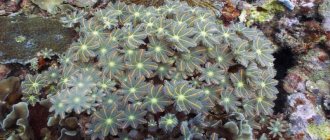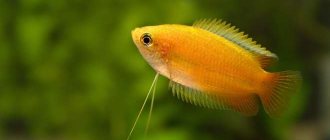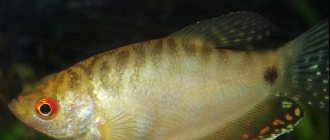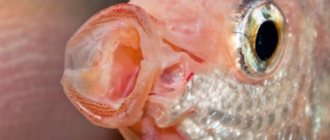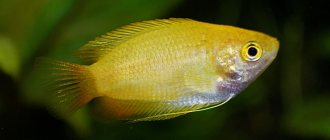Gourami
Simplicity of content:
Latin name: Trichopodus leerii
Lifespan: 10 years
Maximum size: 14 cm.
Average cost: 100 rub.
Pearl gourami is an unpretentious aquarium fish with an attractive appearance. Its bright color and soft character make it possible to add other species of fish as neighbors. Gourami has become popular among aquarists due to its ease of maintenance, ease of care and outstanding appearance.
Description
Gourami are able to breathe air from the surface using a labyrinthine breathing apparatus.
Appearance
Elongated, laterally compressed body. The pelvic fins are long, thread-like, and are used for sensing the surrounding space. The color varies from olive to silver. Pearlescent spots all over the body. The scales form a dark stripe in the middle.
In the wild they grow up to 12 cm. In captivity 7–10 cm.
Behavior
Labyrinth fish lead a peaceful lifestyle, do not fight for territory and do not attack other inhabitants of reservoirs. Pearlfish make sounds that are strong during the spawning period. They recognize the owner. Mother of pearl knocks down insects with thin streams of water.
Lifespan
Life span is from 7 to 9 years.
What are the diseases of pearl gouramis?
Photo of pearl gourami
Remember that the disease of one fish in an aquarium can cause the death of all aquarium animals, so it is better to try to prevent diseases than to treat them. Fish are most often susceptible to diseases due to poor living conditions, injuries during transportation, sudden changes in temperature and water parameters, the quality of the food supplied, especially live food, which can be infected with various parasites. Don’t forget about quarantine for new fish, because it’s very sad to reproach yourself for the death of your much-loved fish after adding a seemingly healthy, but in fact sick, fish to them.
The most common diseases of pearl gourami, as well as other types of gourami, include: lymphocystosis, pseudomonosis, aeromonosis.
Lymphocystis is a viral disease that affects the skin of fish and changes the cells of the mucous membrane. Blisters appearing on the skin can be seen even with the naked eye. The affected cell grows, generates new viruses, and then breaks and all the viruses fall into the water. Most often, the disease appears on the outer edges of the fins, and only then affects cells throughout the body.
Pseudomonosis is a peptic ulcer disease characteristic of many types of aquarium fish, the causative agent of which is aquatic microorganisms from the group of pseudomonas. These organisms can get into the aquarium with soil, plants, and infected fish. When the disease occurs, dark spots form on the fish’s body and then transform into bloody ulcers. And through these ulcers, the doors to other viral infections are opened into the fish’s body. It is best to treat the fish in a separate quarantine aquarium without plants. For treatment, use a solution of potassium permanganate at the rate of 0.5 grams per 10 liters of water. The infected fish are kept in this composition for 15 minutes. if you do not have a quarantine aquarium, then the infected fish can be treated in a general aquarium with bicillin-5, adding 500,000 units of the drug per 100 liters of water, repeat every other day at least six times.
Aeromonosis is an infectious disease, usually caused by the bacterium Aeromonos punctata, which develops in very polluted and cold aquariums.
Sick fish become inactive, lie down on the ground and do not eat. They have a bloated abdomen and “ruffled” scales. Blood stains appear all over the body and fin. This disease is highly contagious and difficult to cure. In this connection, it is often recommended to completely disinfect the aquarium and destroy the fish.
Content
Pearl gourami adapts well to various conditions except cold. Lives a long time, eats any small food and acts as a nurse.
Aquarium
To keep 2-3 young pearl gourami, an aquarium of 40 liters is sufficient, for adults from 100 liters.
Water parameters
Gourami adapt well to new conditions. Maintain the following parameters in the aquarium:
| water temperature | 24–26 degrees |
| acidity | 6.0–7.0 pH |
| rigidity | up to 15 |
The air and water temperatures were at the same level.
Plants
Gourami hide and build nests in the bushes. Set up an aquarium, plant more plants so that there is room for movement. Lush algae such as elodea or pinnate will work well. Place floating plants, such as duckweed, on the surface. Make sure there is access to air.
Priming
A layer of 5–6 cm of coarse river sand, suitable for planted plants.
Place black stones and driftwood at the bottom; the gourami will stand out beautifully against the dark background.
Equipment
Fish love calm waters with minimal current. A new aquarium does not require filtration or aeration equipment.
Lighting
The pearl gourami fish prefers soft, warm light.
What to feed a grumbling gourami
Pearl gourami beautiful photo
When feeding, gourami are completely unpretentious and are ready to feast on any food they find. Like other fish, gourami will be very grateful for a varied diet. After all, feeding any aquarium fish must be correct - balanced, varied. This fundamental rule is the key to successfully keeping any fish. The standard and well-known TetraMin food is perfect for gourami.
It should be noted that when purchasing any dry food, you should pay attention to the date of its manufacture and shelf life, try not to buy food in bulk, and also store the food in a closed state - this will help to avoid the development of pathogenic flora in it.
Compatibility
The compatibility of gourami with other fish is difficult. Pearlies are very peaceful and timid. Aggressive breeds will not allow them to exist normally. Peaceful species can injure gourami by mistaking their fins for worms.
Neighbors not compatible with gourami:
- swordtails;
- goldfish;
- barbs;
- characins;
- cichlids.
Get along well with pearl ones:
- neons;
- iris;
- battles.
Transportation
In order for the fish to tolerate transportation well, it must be transported in water with parameters close to those in which it was kept. If threaders are purchased at a local market or store, they can be brought home in a glass container or plastic bag with a layer of atmospheric air.
Purchased fish can be brought from the store in a glass jar
For long-term transportation, packaging is prepared from two thick plastic bags nested inside each other:
- Corners are insulated with rubber material for strength.
- Pour water into the inner bag and release the fish.
- Leave a sufficient air gap.
- Pack the top of the bag with rubber sealing material.
- Place the package in a durable box, and in the cold season - in a container with good thermal insulation (for example, a foam container).
The most convenient way to transport fish is in standard plastic bags.
One day before the expected delivery, the fish are stopped feeding.
The larger the transport volume and the smaller the number of inhabitants, the better the animals will tolerate the road.
Reproduction
It is possible to breed gourami at home both in a general and in a separate aquarium. But if there are neighbors, the fry may suffer.
Breeding pearl gouramis does not require special skills and is accessible to beginners in aquarium keeping, however, there are some features:
- a pair is chosen for spawning - a male and a female who do not show mutual sympathy will not produce offspring;
- optimal breeding of pearl gouramis at the age of 8–12 months;
- when the female is ready to lay eggs, her abdomen is greatly rounded;
- during dilution, keep the water crystal clear;
- When spawning, provide the gourami with privacy by covering the aquarium with sheets of paper.
Differences between a male and a female
Male gourami are larger in size and have brighter colors, females are more rounded. The dorsal fin is pointed in males and rounded in females. The throat is red in males and orange in females.
Differences during spawning: Boys have a bright red belly.
Spawning
Preparation for spawning has a number of features:
- 6–8 days before mating, plant the gourami;
- feed only live food, but not cyclops or daphnia, otherwise the parents will eat their own fry;
- Spawning can also occur in a community aquarium, but the risk of death of the fry increases.
For a prepared pair, set up a spawning area:
- volume from 30 liters;
- sandy soil;
- It is necessary to have a riccia plant - natural material for the nest;
- Maintain the water level to 15–20 cm;
- the aerator is not used in the spawning tank due to the risk of destruction of the nest;
- for successful spawning, softer water is required - 4–8;
- temperature 29 degrees.
Motherland
Most often found in India and Thailand. All types of gourami live on the islands of Sumatra, Borneo, Java and on the two peninsulas of Indochina and Malay. In nature, pearl, kissing and moon gourami are common.
Types of gourami from right to left: pearl, lalius, marbled, kissing.
The commercial gur is the largest representative of its species and is common in the Greater Sunda Islands. It is not intended for breeding in an aquarium due to its large size. its length reaches 60 cm.
Today, the number of this species has reached a critical level, so in its homeland it is protected and listed in the Red Book.
Gourami live in flowing and still waters. Thanks to the ability to breathe oxygen, they can easily tolerate being in polluted, stagnant ponds, ditches and reservoirs.
Habitats of different species
Among the many types, the most common are:
- Kissing. His homeland is Thailand. The fish received this name due to the structure of its mouthparts. When their lips collide, she makes a special sound similar to a kiss.
- Pearl gourami is the most beautiful species compared to the others. The color of the fish resembles pearl dust.
- Spotted, most often found in Vietnam and Thailand. It can be of different colors and has a calm character.
- Honey. His homeland is India. The color of the fish is yellow-golden.
- Blue lives on the island of Sumatra. Its name comes from its green-blue color, which becomes even brighter with the onset of spawning.
- Red and gold varieties were developed by breeders. They are more demanding, less able to withstand uncomfortable living conditions and have a shorter lifespan.
History of discovery
In the 19th century, the pearl species was discovered by a scientist from France, Pierre Carbonnier, who studied issues related to the acclimatization of tropical animals and was involved in the spread of gourami as an aquarium species. But here difficulties awaited him. At home, the fish lived in ditches and rice fields. The water in them was dirty, stagnant and cloudy. In this regard, the opinion about the great endurance and vitality of the fish has spread. But it was not possible to bring at least one specimen to the Old World; the fish died on the way. After another failure, research and transportation attempts stopped, and the cause of the high mortality rate was clarified only 20 years later.
Gourami rises to the water's edge to capture atmospheric air from the surface, necessary for labyrinthine breathing.
The main feature of pearl gourami is the need to breathe atmospheric air. They began to fill the container halfway with water only in 1896, and then it was possible to transport the first fish to Europe. Later, thanks to A.S. Meshchersky, this species appeared in Russia. He was a well-known aquarist at that time, who bought the gur from Pierre Carbonnier himself.
Diseases
Gourami have strong immunity, but are susceptible to some diseases. If there are unusual changes in appearance or behavior, transfer the fish to another container. Before planting in the main aquarium, be sure to quarantine newcomers for at least 2 weeks.
The most common causes of diseases:
- injuries during transplantation or transportation;
- improper care;
- mismatch of water parameters;
- a sharp drop in temperature;
- excess food;
- poor-quality food or food contaminated with parasites.
More often, health problems are caused by the difference between water and room temperatures. By swallowing cold air, gouramis catch colds. Treatment consists of adjusting temperatures.
Nutrition and behavioral characteristics
And although this species has a calm character, it is still quite timid. In cases of danger, they seek shelter in algae, stones and small holes. With proper care, the life expectancy of females is 12 years, males 14 years. Puberty begins at 8 months. During spawning it makes characteristic clicking sounds. In addition, the pearl gourami recognizes its owner or the people who feed it.
Since the mouth cavity of the fish is quite small, you need to buy small food. Food must be given twice a day.
03:43
Gourami, maintenance, feeding, reproduction, species, aquarium
Types of food:
- Live food. They can be purchased, small bloodworms, coretra, tubifex, daphnia work well, or they can be made from wood lice, earthworms, mealworms and microworms. Artemia is suitable for young specimens.
- Frozen food. Gourami will eat any small frozen food. Tubifex, bloodworms, raspberries, cyclops, microplankton, crushed mussels or shrimp.
- Dry food. It is recommended to add special diets containing carotenoids that improve the color of the fish.
- Products from the human table. Gourami will happily eat finely chopped shrimp and mussels. They should be given no more than 2 times a week. Delicacies for this type are considered to be pre-grated cottage cheese, shavings of meat and processed cheese. You should not feed your fish with similar products more than once every 2 weeks.
- Homemade food. You can make your own food. Now there are many recipes, including for labyrinth fish. Often these foods are protein based, so maintaining a balance will be difficult.
Based on this diagram, you can easily select dry food for your pearls.
Not all gourami will be able to eat the above foods. Small species will not cope with large-sized food, while large fish will not eat small-cut food.
Reviews
Gourami owners speak about pearls in completely different . Some admire the colors of the aquarium resident, others claim that the peaceful nature is a myth.
Interesting Facts
All fish of the genus Trichogaster are considered to be the ancestors of the commercial giant fish that lives off the coast of Indonesia. Its species name is Osphromenus goramy - “true gourami”, while pearl and other species of stringworms, in fact, according to the official classification, have nothing to do with the name goramy.
Modern biologists have so far unofficially classified Trichogasters with another genus - Trichopodus, and both nomenclatures are used by ichthyologists in relation to thread-bearing gourami.
Watching the “pearl” fish, you can note several interesting facts from their life in the aquarium:
Adult gourami can live without food for 2 weeks
- able to tolerate short-term temperature decreases of up to 20 °C and increases of more than 30 °C;
- they like to suck in food from the surface along with water, which then comes out through the gills;
- before eating food, they try to taste it - they mull food fragments in their mouth several times, spit them out, and then swallow them;
- copy behavior, imitating their relatives;
- can live without food brought into the aquarium for up to 2 weeks (during this time they eat harmful algae and are considered “orderlies” of their ecosystem);
- capable of spawning at temperatures not lower than 20 ° C;
- during mating games they can make clicking sounds;
- produce fry significantly smaller in size than the brood produced by the marbled gourami;
- They stop spawning at 14 months, and it is no longer possible to obtain offspring from such individuals.
By crossing different species - a “pearl” male and a “blue” female - a spectacular hybrid was obtained. Morpha inherited a light blue body and a pattern of white spots, but without the pearlescent sheen. It is distinguished by its white tail and scattered orange patches on the anal fin.
Adviсe
- transportation is an important step, do not damage the fins when moving or transplanting;
- cleanliness and temperature of the water are the key to the health of pearl fish;
- a spawning pair that does not show mutual sympathy will not produce offspring;
- mandatory quarantine for newcomers;
- Do not house gouramis with aggressive species.
Exotic and fascinating pearls will decorate the aquarium and will not harm the neighbors. Pearlescent gourami is an excellent option for beginner aquarists.
Previous
FishSecrets of keeping Corydoras catfish
Next
FishWhat do you need to know when keeping flamingos with cichlases?
General information
Pearl gouramis are ray-finned fish of the order Perciformes. They belong to the genus Trichogaster, which includes several species of gourami - thread-carriers. These are typical labyrinthine representatives of tropical, freshwater areas with turbid water and low oxygen content. The pearl gourami has an albino form and, when crossed with the spotted gourami, forms a hybrid morph that can resemble marble gourami.
Pearl gourami is one of the most beautiful representatives of labyrinth fish
Sex differences
Based on the appearance of a fish, it is quite easy to determine which gender it belongs to.
Males are much larger than females, they have brighter colors and pointed fins.
There is also one more feature that is characteristic only of this type of fish: the neck of the male is red, the neck of the female is orange. This difference can be noticed even at a young age, but as the fish grows, it becomes more distinct every year.
Lifespan
In an aquarium, pearl gourami can live 8-9 years. These fish have strong immunity, so they do not get sick often. If favorable living conditions are provided in the aquarium, gourami will live the entire period allotted to them by nature.
Factors that negatively affect life expectancy:
- overcrowded or cramped aquarium;
- injury during transportation;
- temperature violation;
- unfavorable acidity;
- overeating or undereating;
- bad food;
- low temperature in the room where the aquarium is located.
Feeding
The diet of fish should be varied and balanced. The menu should consist of both live and food-grade dry food.
Daphnia, cyclops, plankton, bloodworms or tubifex are suitable as live food. Food must be given twice a day.
Dry food is selected in a special store. It must be calculated for a specific type of fish (in this case, labyrinth fish). Serving sizes and feeding frequency are indicated on the package.
It is important to remember that fish have a small mouth, which means their food must be thoroughly crushed. Also, we must not forget about their modest nature, because more lively fish can quickly swim to the food and eat it completely. Therefore, when feeding, it is important to ensure that there is enough food for everyone.



